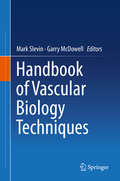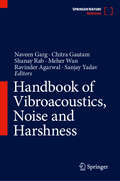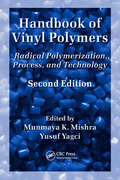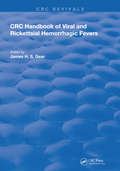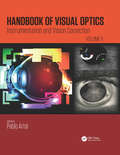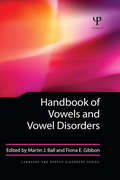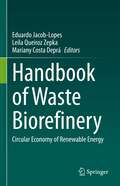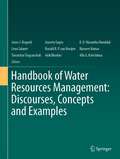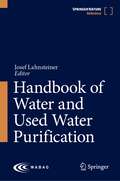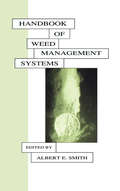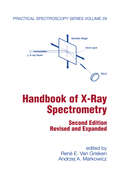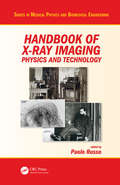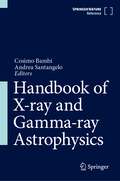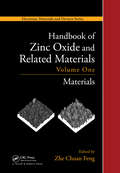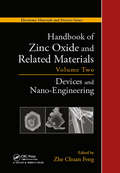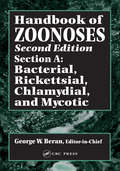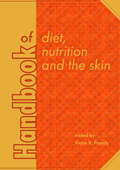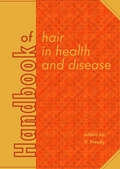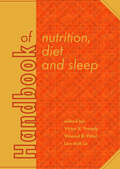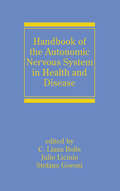- Table View
- List View
Handbook of Vascular Biology Techniques
by Mark Slevin Garry McdowellA wide range of research methods for the study of vascular development, from basic laboratory protocols to advanced technologies used in clinical practice, are covered in this work. A range of methodologies such as molecular imaging platforms and signalling analysis, along with tumour models are collated here. Four sections explore in vitro techniques, in vivo and ex vivo manipulations, imaging and histological analysis and other novel techniques in vascular biology. Readers will discover basic methodologies used for analysis of endothelial cell growth in vitro, including co-culture models of vessel formation. Authors also explore isolation and purification of cells and methods for analysis of data and visualization of localized vasculature with modern imaging platforms. Both animal models and human disease are covered in this work. Each chapter contains helpful sections on trouble shooting, additional notes and links, supporting the reader to carry out protocols. This book will appeal to students, researchers and medical professionals working in all vascular-linked fields such as cardio- and cerebrovascular, cancer and dementia.
Handbook of Vibroacoustics, Noise and Harshness
by Sanjay Yadav Naveen Garg Meher Wan Shanay Rab Chitra Gautam Ravinder AgarwalThe handbook covers the topics of vibro-acoustics, noise, harshness and their related applications in detail. Various topics covered in this handbook are acoustics and vibration metrology, environmental noise measurements, building acoustics, acoustical meta-materials, underwater acoustics, soundscape approach, beam forming approach, 3D noise mapping, in-situ acoustical testing, etc. The handbook would provide a single window source of up-to-date information to the researchers, acousticians, noise and vibration control engineers, metrologists, industry, university graduates, masters, academicians, administrators, policymakers, regulators, and other stakeholders for a better understanding of vibro-acoustics, noise, harshness and related applications.
Handbook of Vinyl Polymers: Radical Polymerization, Process, and Technology, Second Edition
by Yusuf Yagci Munmaya K. MishraRadical polymerization is one of the most widely used means of producing vinyl polymers, supporting a myriad of commercial uses. Maintaining the quality of the critically acclaimed first edition, the Handbook of Vinyl Polymers: Radical Polymerization, Process, and Technology, Second Edition provides a fully updated, single-volume source on t
Handbook of Viral and Rickettsial Hemorrhagic Fevers (Routledge Revivals)
by James H. S. GearFirst Published in 1988: There clearly is a need for a comprehensive account of the hemorrhagic fever viruses and the diseases they cause, as well as of the conditions which may simulate them. There is also a need for an account of the methods for their study and prevention. It is trusted that this handbook will help meet this need.
Handbook of Visual Optics, Volume Two: Instrumentation and Vision Correction
by Pablo ArtalHandbook of Visual Optics offers an authoritative overview of encyclopedic knowledge in the field of physiological optics. It builds from fundamental concepts to the science and technology of instruments and practical procedures of vision correction, integrating expert knowledge from physics, medicine, biology, psychology, and engineering. The chapters comprehensively cover all aspects of modern study and practice, from optical principles and optics of the eye and retina to novel ophthalmic tools for imaging and visual testing, devices and techniques for visual correction, and the relationship between ocular optics and visual perception.
Handbook of Vowels and Vowel Disorders
by Martin J. Ball Fiona E. GibbonIn the general study of speech and phonetics, vowels have stood in second place to consonants. But what vowels are, how they differ from one another, how they vary among speakers, and how they are subject to disorder, are questions that require a closer examination. This Handbook presents a comprehensive, cogent, and up-to-date analysis of the vowel, including its typical development in children's speech, description by perceptual and instrumental methods, cross-linguistic and sociolinguistic aspects, and disorders of its production and use. It approaches the problems of vowel production and perception from the viewpoints of physiology, physics, psychology, linguistics, phonetics, phonology, and speech-language pathology. The chapters are logically complementary, and the major sections of the book are like key dimensions of understanding, each adding a perspective and base of knowledge on vowels. The sum total of the chapters is a synthesis of information on vowels that has no precedent.
Handbook of Waste Biorefinery: Circular Economy of Renewable Energy
by Eduardo Jacob-Lopes Leila Queiroz Zepka Mariany Costa DepráThis handbook discusses the latest developments in biorefinery technologies for waste-to-energy conversion. The growing global population and the accompanying increase in consumption and waste production make it urgent to find the best possible use of our resources. A sustainable waste management under the biorefinery concept has great potential to support a sustainable circular economy and green energy production.This handbook is divided into four parts. First, the reader is introduced to the fundamentals and recent trends of waste-to-energy technologies. The second part describes in detail the current status, challenges, and potential of the different feedstocks used for waste-to-energy conversion. Here, municipal solid waste, sewage sludge, oils and greases generated during food preparation, industrial wastewaters, and agricultural wastes, to name a few, are introduced. In the third part, numerous waste-to-energy technologies are discussed in detail, including anaerobic digestion, composting, gasification, plasma technology, thermal cracking, and others. Advantages and optimization potentials of these technologies for efficient residue management, quality and yield are highlighted.Finally, the handbook discusses social, environmental and economic aspects of waste-to-energy biorefinery technologies. Readers will learn more about the major bottlenecks and solutions in bioenergy commercialization, the logistics of biomass supply and the carbon footprint of waste biorefineries. The ideas and technologies presented in this book contribute to the UN Sustainable Development Goal (SDG) of "Affordable and Clean Energy".This book is a useful reference for postgraduate students and researchers interested in biorefinery and biofuel technologies, both in academia- and commercial laboratories. Early career scientists can use it to fast track into the field. Advanced scientists will find it helpful in gaining a broader overview of the field beyond their area of specialization.
Handbook of Water Analysis
by Leo M. L. Nollet Leen S. P. De GelderExtensively revised and updated, Handbook of Water Analysis, Third Edition provides current analytical techniques for detecting various compounds in water samples. Maintaining the detailed and accessible style of the previous editions, this third edition demonstrates water sampling and preservation methods by enumerating different ways to measure c
Handbook of Water Resources Management: Discourses, Concepts and Examples
by Joyeeta Gupta Anik Bhaduri Janos J. Bogardi K. D. Wasantha Nandalal Léna Salamé Ronald R. P. van Nooijen Navneet Kumar Tawatchai Tingsanchali Alla G. KolechkinaThis book provides an overview of facts, theories and methods from hydrology, geology, geophysics, law, ethics, economics, ecology, engineering, sociology, diplomacy and many other disciplines with relevance for concepts and practice of water resources management. It provides comprehensive, but also critical reading material for all communities involved in the ongoing water discourses and debates.The book refers to case studies in the form of boxes, sections, or as entire chapters. They illustrate success stories, but also lessons to be remembered, to avoid repeating the same mistakes. Based on consolidated state-of-the-art knowledge, it has been conceived and written to attract a multidisciplinary audience.The aim of this handbook is to facilitate understanding between the participants of the international water discourse and multi-level decision making processes. Knowing more about water, but also about concepts, methods and aspirations of different professional, disciplinary communities and stakeholders professionalizes the debate and enhances the decision making.
Handbook of Water and Used Water Purification
by Josef LahnsteinerThe book addresses the entire water cycle. The focus is on new technologies/processes (especially in high performance biological treatment), energy recovery, water recycling and reuse. Recommendations with regard to the right technologies/processes for specific situations are provided and a wide range of case studies, especially in emerging markets. In addition, the most modern water terminology with more positive connotations is used. This is especially important in the field of direct and indirect potable reuse (DPR and IPR respectively).
Handbook of Weed Management Systems
by Albert E. SmithThis work provides the fundamental information necessary for the development of weed management strategies for all the major US crops using concepts that can be applied worldwide. Weed management systems are provided for cotton, peanut, soybean, wheat, barley, oat, sorghum, rice, fruits, nut crops, and more. The dynamics involved in creating the best management approaches for specific types of crops are explained.
Handbook of Wind Energy Aerodynamics
by Bernhard Stoevesandt Gerard Schepers Peter Fuglsang Yuping SunThis handbook provides both a comprehensive overview and deep insights on the state-of-the-art methods used in wind turbine aerodynamics, as well as their advantages and limits. The focus of this work is specifically on wind turbines, where the aerodynamics are different from that of other fields due to the turbulent wind fields they face and the resultant differences in structural requirements. It gives a complete picture of research in the field, taking into account the different approaches which are applied. This book would be useful to professionals, academics, researchers and students working in the field.
Handbook of Wind Resource Assessment
by Simon WatsonHANDBOOK OF WIND RESOURCE ASSESSMENT Useful reference text underpinning the theory behind wind resource assessment along with its practical application Handbook of Wind Resource Assessment provides a comprehensive description of the background theory, methods, models, applications, and analysis of the discipline of wind resource assessment, covering topics such as climate variability, measurement, wind distributions, numerical modeling, statistical modeling, reanalysis datasets, applications in different environments (onshore and offshore), wind atlases, and future climate. The text provides an up-to-date assessment of the tools available for wind resource assessment and their application in different environments. It also summarizes our present understanding of the wind climate and its variability, with a particular focus on its relevance to wind resource assessment. Written by a highly qualified professional in the fields of wind resource assessment, wind turbine condition monitoring, and wind turbine wake modeling, sample topics included in Handbook of Wind Resource Assessment are as follows: Climate variability, covering temporal scales of variation, power spectrum, short term variation and turbulence, the spectral gap, and long-term variation Measurement, covering history of wind speed measurement, types of measurement, terrestrial measurements, anemometers, wind vanes, lidars, sodars and remote sensing Distributions, covering synoptic scale wind distributions, turbulent scale distributions, contrast between mean and extreme values, and extreme value statistics Physical modeling, covering spatial scales of variability, the governing equations, models of varying complexity, mass consistent models, linearized models and semi-empirical models Statistical modeling, covering the use of measure-correlate-predict (MCP), wind indices and spatial interpolation Handbook of Wind Resource Assessment serves as a comprehensive text that brings together the different aspects of wind resource assessment in one place. It is an essential resource for anyone who wishes to understand the underlying science, models, or applications of wind resources, including postgraduates, academics, and wind resource professionals.
Handbook of Wood Chemistry and Wood Composites
by Roger M. RowellWood has played a major role throughout human history. Strong and versatile, the earliest humans used wood to make shelters, cook food, construct tools, build boats, and make weapons. Recently, scientists, politicians, and economists have renewed their interest in wood because of its unique properties, aesthetics, availability, abundance, and perha
Handbook of X-Ray Spectrometry (Practical Spectroscopy)
by Rene E. Van Grieken Andrzej A. Markowicz"Updates fundamentals and applications of all modes of x-ray spectrometry, including total reflection and polarized beam x-ray fluorescence analysis, and synchrotron radiation induced x-ray emission. Promotes the accurate measurement of samples while reducing the scattered background in the x-ray spectrum."
Handbook of X-ray Imaging: Physics and Technology (Series in Medical Physics and Biomedical Engineering)
by Paolo RussoContaining chapter contributions from over 130 experts, this unique publication is the first handbook dedicated to the physics and technology of X-ray imaging, offering extensive coverage of the field. This highly comprehensive work is edited by one of the world’s leading experts in X-ray imaging physics and technology and has been created with guidance from a Scientific Board containing respected and renowned scientists from around the world. The book's scope includes 2D and 3D X-ray imaging techniques from soft-X-ray to megavoltage energies, including computed tomography, fluoroscopy, dental imaging and small animal imaging, with several chapters dedicated to breast imaging techniques. 2D and 3D industrial imaging is incorporated, including imaging of artworks. Specific attention is dedicated to techniques of phase contrast X-ray imaging. The approach undertaken is one that illustrates the theory as well as the techniques and the devices routinely used in the various fields. Computational aspects are fully covered, including 3D reconstruction algorithms, hard/software phantoms, and computer-aided diagnosis. Theories of image quality are fully illustrated. Historical, radioprotection, radiation dosimetry, quality assurance and educational aspects are also covered. This handbook will be suitable for a very broad audience, including graduate students in medical physics and biomedical engineering; medical physics residents; radiographers; physicists and engineers in the field of imaging and non-destructive industrial testing using X-rays; and scientists interested in understanding and using X-ray imaging techniques. The handbook's editor, Dr. Paolo Russo, has over 30 years’ experience in the academic teaching of medical physics and X-ray imaging research. He has authored several book chapters in the field of X-ray imaging, is Editor-in-Chief of an international scientific journal in medical physics, and has responsibilities in the publication committees of international scientific organizations in medical physics. Features: Comprehensive coverage of the use of X-rays both in medical radiology and industrial testing The first handbook published to be dedicated to the physics and technology of X-rays Handbook edited by world authority, with contributions from experts in each field
Handbook of X-ray and Gamma-ray Astrophysics
by Cosimo Bambi Andrea SantangeloThis book highlights a comprehensive coverage of X‐ray and Gamma‐ray astrophysics. The first and the second parts discuss, respectively, X-ray and Gamma-ray experimental techniques and observatories. The third part is devoted to science, including galactic and extragalactic sources. The fourth and last parts are dedicated to analysis techniques in X-ray and Gamma-ray astronomy: spectral analysis, imagining analysis, timing analysis, and polarimetric analysis. Presenting the state of the art in X-ray and gamma-ray astronomy, this is both a valuable book for students and an important reference resource for researchers in the field.
Handbook of Zeolite Science and Technology
by Scott M. Auerbach Kathleen A. Carrado Prabir K. DuttaThe Handbook of Zeolite Science and Technology offers effective analyses ofsalient cases selected expressly for their relevance to current and prospective research. Presenting the principal theoretical and experimental underpinnings of zeolites, this international effort is at once complete and forward-looking, combining fundamental
Handbook of Zinc Oxide and Related Materials: Volume One, Materials
by Zhe Chuan FengThrough their application in energy-efficient and environmentally friendly devices, zinc oxide (ZnO) and related classes of wide gap semiconductors, including GaN and SiC, are revolutionizing numerous areas, from lighting, energy conversion, photovoltaics, and communications to biotechnology, imaging, and medicine. With an emphasis on engineering a
Handbook of Zinc Oxide and Related Materials: Volume Two, Devices and Nano-Engineering
by Zhe Chuan FengThrough their application in energy-efficient and environmentally friendly devices, zinc oxide (ZnO) and related classes of wide gap semiconductors, including GaN and SiC, are revolutionizing numerous areas, from lighting, energy conversion, photovoltaics, and communications to biotechnology, imaging, and medicine. With an emphasis on engineering a
Handbook of Zoonoses, Second Edition, Section A: Bacterial, Rickettsial, Chlamydial, and Mycotic Zoonoses
by George W. BeranThis multivolume handbook presents the most authoritative and comprehensive reference work on major zoonoses of the world. The Handbook of Zoonoses covers most diseases communicable to humans, as well as those diseases common to both animals and humans. It identifies animal diseases that are host specific and reviews the effects of various human diseases on animals. Discussions address diseases that remain important public and animal health problems and the techniques that can control and prevent them.The chapters are written by internationally recognized scientists in their respective areas of disease, who work or have worked extensively in the most affected areas of the world. The emphasis for each zoonosis is on the epidemiology of the disease, the clinical syndromes and carrier states in infected animals and humans, and the most current methods for diagnosis and approaches to control. For infectious agents or biologic toxins, which may be transmitted by foods of animal origin, a strong focus is placed on food safety measures. The etiologic and therapeutic aspects of each disease important to epidemiology and control are identified.
Handbook of diet, nutrition and the skin
by Victor R. PreedyStudies have clearly shown that optimal diet and nutrition can prevent skin disease. Moreover, novel nutritional components have been used experimentally to treat skin conditions. However, the clinical application of these nutrients awaits confirmation. It is thus up to health care professionals to present new knowledge in order to provide advice or treatments for skin problems. This handbook provides, in a single volume, comprehensive coverage of the relation between skin and diet and nutrition in its broadest sense. The Handbook of diet, nutrition and the skin consists of sections on general aspects of skin, nutrition and diet, micronutrients, nutraceuticals, cancer and specific skin conditions. Unique features of each chapter in this volume include relevant and useful 'key facts' which highlight interesting or important findings of the specific subjects and 'summary points' that are designed to abstract each chapter in take home messages. This handbook will be of interest to a wide range of readers, such as dermatologists, doctors, nurses and those interested in, or working within the area of skin health. This will of course also include nutritionists and dieticians, dermatologists, cosmetic scientists, health workers and practitioners, college and university lecturers and undergraduate and graduate students.
Handbook of hair in health and disease
by Victor R. PreedyHair is a major component of the body's tissue system that contributes to the individual's make up and confers a large degree of personal identity. Apart from its visible façade, hair also has a functional role. It has an unique structure and complex molecular development. The very nature of hair makes it a suitable marker for the prognosis of disease. Hair can also be used to screen for toxins and changes in the diet. However, there are currently no suitable publications available that describe hair in a rational scientific context. This handbook provides an academic approach to hair in health and disease. Divided into five sections the Handbook of Hair in Health and Disease provides an insight into hair growth and loss, molecular and cellular biology of hair, dietary toxicity and pathological history, diseases and treatments of hair, as well as shampoos and conditioners. Unique features of each chapter in this volume include relevant and useful 'Key facts' which highlight interesting or important findings of the specific subjects and 'Summary points' that will give a clear overview of the subjects treated in each chapter. The Handbook of Hair in Health and Disease will be essential to a variety of users, such as trichologists, doctors and nurses and all those interested or working within the area of hair health. This includes nutritionists and dieticians, scientific beauticians, health workers and practitioners, college and university lecturers and undergraduate and graduate students.
Handbook of nutrition, diet and sleep
by Victor R. Preedy Vinood B. Patel Lan-Anh LeEmerging literature and research have currently shown that sleep, sleep disturbances, diet and nutrition are interlinked in numerous ways. For example, sleep deprivation alters food intake and snacking behaviour. On the other hand, dietary restriction and obesity alter sleep. Specific nutrients such as caffeine and alcohol also affect sleep. Furthermore, variations in these relationships differ with respect to age, gender and state of health. There is a connection between sleep and disordered nutrition as defined by conditions such as diabetes and metabolic syndrome. This book demonstrates that disruptive sleep patterns can be remedied by appropriate dietary or nutritional changes including the usage of supplements. The contribution of sleep to our daily lives is not yet fully understood, but it is clear that its impact should not be underestimated. This handbook discusses the important relationship between diet and nutrition and disruptive or abnormal sleep in the sub-clinical or clinical setting. Authorities in the field offer a wide range of scientifically sound perspectives and approaches of the link between sleep, nutrition and diet.
Handbook of the Autonomic Nervous System in Health and Disease
by Liana Bolis Julio Licinio Stefano GovoniExamines the role of the ANS in the maintenance and control of bodily homeostasis, as well as in the pathogenesis, pathophysiology, and treatment of disorders such as cardiovascular disease, hypertension, asthma, arrhythmia, diabetes, ischemia, myocardial infarction, urinary retention, and depression.
